
- Finals Results: Men’s Double Mini | Women’s Tumbling | Synchro
- Photo Gallery
- FIG Worlds Microsite
ST. PETERSBURG, Russia, Nov. 9, 2018 – Competing in his first World Championships, Ruben Padilla of Oakley, Calif./Wasatch Trampoline & Tumbling, won the men’s double mini-trampoline silver medal at the 2018 World Trampoline and Tumbling Championships at the Sports and Concert Coliseum (SKK) in St. Petersburg, Russia. The World Championships concludes tomorrow with the finals for women’s double-mini and men’s tumbling, as well as the semifinals and finals for men’s and women’s trampoline. The USA Gymnastics twitter feed, @usagym, will have live coverage from the championships, and original stories and photos on usagym.org. U.S.-based fans can watch same-day coverage of the finals on the Olympic Channel and OlympicChannel.com.
The gymnasts competing on the final day are listed below. The trampoline semifinals are set for 1:30 p.m., with the finals for women’s double-mini; men’s tumbling; and men’s and women’s trampoline beginning at 4 p.m. Both times are local to St. Petersburg.
- Women’s trampoline, semifinal
- Nicole Ahsinger, Lafayette, La./Trampoline and Tumbling Express
- Kaden Brown, Herriman, Utah/Wasatch Trampoline & Tumbling
- *Alex Renkert, Columbus, Ohio/Integrity Athletics, first reserve athlete
- Kristle Lowell, Orland Park, Ill./Morgan Park Sports Center
- Tristan Van Natta, Hilliard, Ohio/Integrity Athletics
Men’s tumbling
Women’s double mini-trampoline
Padilla, who performed two passes that he had not done in competition before, tallied a total of 73.500 to snare the men’s double-mini silver medal. His first score of 37.400 was the second best for the first routine pass, and his second routine was the third highest for the second round. Matthew Hawkins of Phoenix, Ariz./North Valley Gymnastics, earned a 71.900 for fourth, just missing the podium. Russia’s Mikhail Zalomin won the title at 78.200, with Argentina’s Lucas Adorno taking third (72.400).
Hope Bravo of Dallas, Texas/Eagle Gymnastics Academy, set a personal best score of 66.300, which landed her in sixth place. China’s Jia Fangfang won the title at 71.100. Britain’s Shanice Davidson and Russia’s Viktoria Danilenko tied at 69.500, but Davidson received the silver via the tie-breaker.
In women’s synchronized trampoline, Nicole Ahsinger and Sarah Webster, both of Lafayette, La./Trampoline and Tumbling Express, ended up in fifth place with an 18.720 after an error in skills performed. Japan won the women’s synchronized trampoline title (48.340), with Canada and Mexico finishing second (47.500) and third (43.950), respectively. In the men’s final, Belarus garnered the gold (52.510), France the silver (51.850), and Australia the bronze (51.270).
Competition format
The competition format for each event is outlined below, and medals will be awarded for each.
- All-around team competition. At the conclusion of the qualifying rounds, the eight best scores (one per event) for each country will be added together for the all-around team qualifying score. The five countries with the highest score will advance to the all-around final, and each team includes one athlete for each event, along with one men’s and one women’s synchro pair. In the final, the eight gymnasts whose scores counted for each of the events for the qualifying total will compete on their country’s team.
- Individual trampoline. Each athlete performs two routines (compulsory and voluntary) in the qualification round but performs only one routine in the semifinals and finals. The top 24 men and 24 women advance to the semifinals, with the top eight advancing to the finals.
- Synchronized trampoline. Each duo performs two routines (compulsory and voluntary) in the qualification round, and the top eight advance to the finals.
- Tumbling. Each gymnast performs two passes and the eight highest combined scores advance to the individual tumbling finals, where they perform another two passes. Highest combined score for the two final passes wins.
- Double mini-trampoline. Gymnasts perform two passes in the qualification round, and the top eight two-pass scores advance to the finals. Gymnasts again perform two passes in the finals to determine the champion.
- Tie-breaking. Ties will be broken, and information on the tie-breaking process may be accessed here.
Ways to follow the action
Fans can follow the competition action several different ways.
- USA Gymnastics website and social media. usagym.org will have event coverage, original stories, photos and more. USA Gymnastics twitter feed will have live coverage from St. Petersburg.
- U.S. TV and online coverage. Tape-delayed coverage of the finals will air on the Olympic Channel on Nov. 8 from 6-7:30 p.m. ET and Nov. 9-10 from 6-8 p.m. ET, with a simulcast on OlympicChannel.com each day.
- Live scoring: The International Gymnastics Federation is offering live scoring for the qualifications and finals, which is also available on the FIGymnastics mobile application.
- FIG and LOC websites: The FIG and LOC event pages will also have news, live scoring, official results, medal standings and a complete competition program.
- FIG daily highlight clips. A highlight package will be uploaded to the FIG YouTube channel each day, while qualification routines from each athlete will be made available after the championships.
Based in Indianapolis, USA Gymnastics is the national governing body for gymnastics in the United States. The organization is committed to creating a culture that encourages and supports its athletes and focuses on its highest priority, the safety and well-being of the athletes. USA Gymnastics has already taken specific, concrete steps to strengthen its safe sport policies and procedures. The organization’s disciplines include men’s and women’s artistic gymnastics, rhythmic gymnastics, trampoline and tumbling, acrobatic gymnastics and gymnastics for all (formerly known as group gymnastics). For more complete information, log on to usagym.org.




